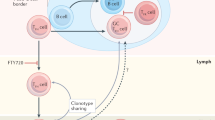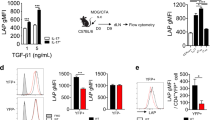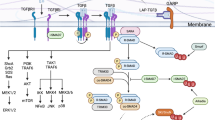Abstract
The checkpoints and mechanisms that contribute to autoantibody-driven disease are as yet incompletely understood. Here we identified the axis of interleukin 23 (IL-23) and the TH17 subset of helper T cells as a decisive factor that controlled the intrinsic inflammatory activity of autoantibodies and triggered the clinical onset of autoimmune arthritis. By instructing B cells in an IL-22- and IL-21-dependent manner, TH17 cells regulated the expression of β-galactoside α2,6-sialyltransferase 1 in newly differentiating antibody-producing cells and determined the glycosylation profile and activity of immunoglobulin G (IgG) produced by the plasma cells that subsequently emerged. Asymptomatic humans with rheumatoid arthritis (RA)-specific autoantibodies showed identical changes in the activity and glycosylation of autoreactive IgG antibodies before shifting to the inflammatory phase of RA; thus, our results identify an IL-23–TH17 cell–dependent pathway that controls autoantibody activity and unmasks a preexisting breach in immunotolerance.
This is a preview of subscription content, access via your institution
Access options
Subscribe to this journal
Receive 12 print issues and online access
$209.00 per year
only $17.42 per issue
Buy this article
- Purchase on Springer Link
- Instant access to full article PDF
Prices may be subject to local taxes which are calculated during checkout






Similar content being viewed by others
References
McInnes, I.B. & Schett, G. The pathogenesis of rheumatoid arthritis. N. Engl. J. Med. 365, 2205–2219 (2011).
Ji, H. et al. Arthritis critically dependent on innate immune system players. Immunity 16, 157–168 (2002).
Grant, E.P. et al. Essential role for the C5a receptor in regulating the effector phase of synovial infiltration and joint destruction in experimental arthritis. J. Exp. Med. 196, 1461–1471 (2002).
Kleinau, S., Martinsson, P. & Heyman, B. Induction and suppression of collagen-induced arthritis is dependent on distinct Fcγ receptors. J. Exp. Med. 191, 1611–1616 (2000).
Svensson, L., Jirholt, J., Holmdahl, R. & Jansson, L. B cell-deficient mice do not develop type II collagen-induced arthritis (CIA). Clin. Exp. Immunol. 111, 521–526 (1998).
Matsumoto, I., Staub, A., Benoist, C. & Mathis, D. Arthritis provoked by linked T and B cell recognition of a glycolytic enzyme. Science 286, 1732–1735 (1999).
Holmdahl, R., Rubin, K., Klareskog, L., Larsson, E. & Wigzell, H. Characterization of the antibody response in mice with type II collagen-induced arthritis, using monoclonal anti-type II collagen antibodies. Arthritis Rheum. 29, 400–410 (1986).
van Venrooij, W.J., van Beers, J.J. & Pruijn, G.J. Anti-CCP antibodies: the past, the present and the future. Nat. Rev. Rheumatol. 7, 391–398 (2011).
Renato, G.M. B cell depletion in early rheumatoid arthritis: a new concept in therapeutics. Ann. NY Acad. Sci. 1173, 729–735 (2009).
Rantapää-Dahlqvist, S. et al. Antibodies against cyclic citrullinated peptide and IgA rheumatoid factor predict the development of rheumatoid arthritis. Arthritis Rheum. 48, 2741–2749 (2003).
Berglin, E. et al. A combination of autoantibodies to cyclic citrullinated peptide (CCP) and HLA-DRB1 locus antigens is strongly associated with future onset of rheumatoid arthritis. Arthritis Res. Ther. 6, R303–R308 (2004).
Shiozawa, K. et al. Anticitrullinated protein antibody, but not its titer, is a predictor of radiographic progression and disease activity in rheumatoid arthritis. J. Rheumatol. 39, 694–700 (2012).
Ursum, J., Bos, W.H., van Dillen, N., Dijkmans, B.A. & van Schaardenburg, D. Levels of anti-citrullinated protein antibodies and IgM rheumatoid factor are not associated with outcome in early arthritis patients: a cohort study. Arthritis Res. Ther. 12, R8 (2010).
Lubberts, E. The IL-23-IL-17 axis in inflammatory arthritis. Nat. Rev. Rheumatol. 11, 425–429 (2015).
Leipe, J. et al. Role of Th17 cells in human autoimmune arthritis. Arthritis Rheum. 62, 2876–2885 (2010).
Murphy, C.A. et al. Divergent pro- and antiinflammatory roles for IL-23 and IL-12 in joint autoimmune inflammation. J. Exp. Med. 198, 1951–1957 (2003).
Yamada, H. et al. Th1 but not Th17 cells predominate in the joints of patients with rheumatoid arthritis. Ann. Rheum. Dis. 67, 1299–1304 (2008).
Pöllinger, B. IL-17 producing T cells in mouse models of multiple sclerosis and rheumatoid arthritis. J. Mol. Med. 90, 613–624 (2012).
Corrigall, V.M. & Panayi, G.S. Autoantigens and immune pathways in rheumatoid arthritis. Crit. Rev. Immunol. 22, 281–293 (2002).
Nimmerjahn, F. & Ravetch, J.V. Antibody-mediated modulation of immune responses. Immunol. Rev. 236, 265–275 (2010).
Anthony, R.M. et al. Recapitulation of IVIG anti-inflammatory activity with a recombinant IgG Fc. Science 320, 373–376 (2008).
Cornelissen, F. et al. IL-23 dependent and independent stages of experimental arthritis: no clinical effect of therapeutic IL-23p19 inhibition in collagen-induced arthritis. PLoS One 8, e57553 (2013).
Mitsdoerffer, M. et al. Proinflammatory T helper type 17 cells are effective B-cell helpers. Proc. Natl. Acad. Sci. USA 107, 14292–14297 (2010).
Hirota, K. et al. Plasticity of TH17 cells in Peyer's patches is responsible for the induction of T cell-dependent IgA responses. Nat. Immunol. 14, 372–379 (2013).
Hsu, H.C. et al. Interleukin 17-producing T helper cells and interleukin 17 orchestrate autoreactive germinal center development in autoimmune BXD2 mice. Nat. Immunol. 9, 166–175 (2008).
Wu, H.J. et al. Gut-residing segmented filamentous bacteria drive autoimmune arthritis via T helper 17 cells. Immunity 32, 815–827 (2010).
Scherer, H.U. et al. Glycan profiling of anti-citrullinated protein antibodies isolated from human serum and synovial fluid. Arthritis Rheum. 62, 1620–1629 (2010).
Rombouts, Y. et al. Anti-citrullinated protein antibodies acquire a pro-inflammatory Fc glycosylation phenotype prior to the onset of rheumatoid arthritis. Ann. Rheum. Dis. 74, 234–241 (2015).
Oefner, C.M. et al. Tolerance induction with T cell-dependent protein antigens induces regulatory sialylated IgGs. The Journal of allergy and clinical immunology 129, 1647–1655 e1613 (2012).
Hess, C. et al. T cell-independent B cell activation induces immunosuppressive sialylated IgG antibodies. J. Clin. Invest. 123, 3788–3796 (2013).
Genovese, M.C. et al. Efficacy and safety of secukinumab in patients with rheumatoid arthritis: a phase II, dose-finding, double-blind, randomised, placebo controlled study. Ann. Rheum. Dis. 72, 863–869 (2013).
Becker, C. et al. Cutting edge: IL-23 cross-regulates IL-12 production in T cell-dependent experimental colitis. J. Immunol. 177, 2760–2764 (2006).
Nandakumar, K.S. & Holmdahl, R. Efficient promotion of collagen antibody induced arthritis (CAIA) using four monoclonal antibodies specific for the major epitopes recognized in both collagen induced arthritis and rheumatoid arthritis. J. Immunol. Methods 304, 126–136 (2005).
Ayoglu, B. et al. Autoantibody profiling in multiple sclerosis using arrays of human protein fragments. Mol. Cell. Proteomics 12, 2657–2672 (2013).
Lindh, I. et al. Type II collagen antibody response is enriched in the synovial fluid of rheumatoid joints and directed to the same major epitopes as in collagen induced arthritis in primates and mice. Arthritis Res. Ther. 16, R143 (2014).
Harre, U. et al. Glycosylation of immunoglobulin G determines osteoclast differentiation and bone loss. Nat. Commun. 6, 6651 (2015).
Rombouts, Y. et al. Extensive glycosylation of ACPAs-IgG variable domains modulates binding to citrullinated antigens in rheumatoid arthritis. Ann. Rheum. Dis. 75, 578–585 (2015).
Selman, M.H. et al. Fc specific IgG glycosylation profiling by robust nano-reverse phase HPLC-MS using a sheath-flow ESI sprayer interface. J. Proteomics 75, 1318–1329 (2012).
Zal, T., Volkmann, A. & Stockinger, B. Mechanisms of tolerance induction in major histocompatibility complex class II-restricted T cells specific for a blood-borne self-antigen. J. Exp. Med. 180, 2089–2099 (1994).
Lutz, M.B. et al. An advanced culture method for generating large quantities of highly pure dendritic cells from mouse bone marrow. J. Immunol. Methods 223, 77–92 (1999).
Krönke, G. et al. Oxidized phospholipids induce expression of human heme oxygenase-1 involving activation of cAMP-responsive element-binding protein. J. Biol. Chem. 278, 51006–51014 (2003).
Acknowledgements
We thank C. Stoll, A. Klej and U. Appelt for technical assistance; Boehringer-Ingelheim for the fully mouse antibody to mouse IL-23p19; MD Bioscience for the collagen-antibody-induced arthritis 'cocktail'; and K. Ralph, D. Souza and G. Nabozny (Boehringer Ingelheim Pharmaceuticals) for technical advice and monoclonal antibody to anti-IL23. Supported by Deutsche Forschungsgemeinschaft (CRC1181 to G.K., G.S., F.N., C.B. and D.D.; SPP1468-IMMUNOBONE to G.K., G.S. and F.N.; and CRC643 to G.S., F.N. and D.D.), the European Union (ERC StG 640087 – SOS to G.K.; MASTERSWITCH project to G.S.; and BTCure to G.S. and C.B.), the Interdisciplinary Centre for Clinical Research, Erlangen (IZKF A55 to G.K.; and A68 to G.K. and F.N.), the Bundesministerium für Bildung und Forschung (METARTHROS to G.K. and G.S.), the Else-Kröner Fresenius Stiftung (2013_A274 to G.K.), the ELAN Fonds of the Universitätsklinikum Erlangen (14-10-17-1 to G.H.), the Strategic Science Foundation (R.H.), the KAWallenberg Fondation (R.H.) and the Bavarian Genome Network (BayGene to D.D.).
Author information
Authors and Affiliations
Contributions
R.P. designed the study, performed and interpreted experiments and wrote the manuscript; T.R., N.I., S.C., U.H., J.A.A., M.S., B.H. and P.D. performed experiments and collected and interpreted the data; H.U.S, R.T., T.H.W. and R.H. provided help during the design of the study and wrote the manuscript; A.K., S.U. and A.J.H. designed the study and experiments and interpreted data; G.F.H., C.G., S.Bö., A.L., I.M., K.S.N. and E.L. measured samples and interpreted the data; C.B. was involved in the generation of Il23a−/− mice and provided input; W.S. and D.D. provided expertise and input and wrote the manuscript; M.W., Y.R. and C.A.K. measured and interpreted the glycostructure of IgG; M.H., S Bl., F.N., G.S. and G.K. designed the study and experiments and wrote the manuscript; and all authors read and commented on the manuscript.
Corresponding author
Ethics declarations
Competing interests
The authors declare no competing financial interests.
Integrated supplementary information
Supplementary Figure 1 Il23a−/− mice develop regular arthritis induced by the transfer of K/BxN serum.
(a) Clinical scoring of arthritis in wild type (WT) and Il23a−/− mice that received serum from arthritic K/BxN mice. Error bars represent SEM *P<0.05; **P<0.01; ***P<0.001; Student’s t test.
Supplementary Figure 2 Humoral immune response in wild-type and Il23a−/− mice during CIA.
(a-d) Analysis of levels of (a) collagen type II (CII)-specific IgG, (b) CII-specific IgG subsets, (c) IgG specifically directed against murine CII (d) and IgG detecting different murine CII epitopes in the sera of WT and Il23a−/− mice at day 50 after induction of collagen-induced arthritis (CIA). (e) KSCN titration assay for the determination of the binding affinity of CII-specific IgG in WT and Il23a−/− mice. (f,g) Analysis of the appearance of (f) germinal centers and the appearance of germinal center (CD19 pre-gated) B cells (g) at day 26 after induction of CIA in WT and Il23a−/− mice. (h) Measurement of the levels of regular and high affinity antibodies in response to a T cell dependent immunization with 4-hydroxy-3-nitrophenylacetyl (NP) coupled to chicken g-globulin (NP-CGG) in WT and Il23a−/− mice. Error bars represent SEM*P<0.05; **P<0.01; ***P<0.001; Student’s t test.
Supplementary Figure 3 Analysis of the glycostructure of CII-specific IgG by mass spectrometry.
Representative mass spectra illustrating IL-23-dependent changes of the glycosylation at Asn-297 of the indicated IgG subclasses of collagen type II-specific IgG isolated from the sera of WT and Il23a−/− mice at day 50 after induction of CIA.
Supplementary Figure 4 Identification of plasma cells and plasmablasts.
(a) Sorting strategy and sorting purity analysis of splenic plasma cells (CD19+CD138+B220-) and plasmablasts (CD19+CD138lowB220+) for mRNA-analysis. (b) Gating strategy for the flow cytometric analysis of St6gal1 protein expression in splenic Ova-specific plasmacells and plasmacells isolated during collagen-induced arthritis. Plasmacells were gated to be B220lowCD138+Taci+ and Ova+, respectively.
Supplementary Figure 5 Characterization of the TH17 response during CIA.
(a) Flow-cytometric analysis of the content of IL-17-expressing CD3+ T cells in spleen, inguinal lymph nodes (LN) and paws of wild-type (WT) DBA mice at indicated time points during the course of collagen-induced arthritis (CIA). (b) Mean percentage and fold change of the numbers as well as (c) total cells/organ of indicated T cell subsets in spleen, LN and paws of WT DBA/1 mice at indicated time points after induction of CIA. CD4+CD3+ T cells were subcategorized into IFNγ-expressing Th1 cells, IL-4-expressing Th2 cells, IL-17-expressing TH17 cells and FoxP3-expressing Treg cells. (d) Frequency of IL-17-positive, IL-22-positive and IL-17/IL-22 double-positive T cells in spleens and lymph nodes of WT mice at the indicated time points after induction of CIA. (e) Identification of CD4+Bcl-6+IL17+ T cells within germinal centers of the spleen 26 days after induction of CIA (f) Proposed model of the IL23/Th17-mediated control of autoantibody activity. (g) Flow cytometry-based quantification of the expression of the IL-22 receptor (IL22Rα1) on CD19+B220+ B cells that were differentiated into plasmablasts by incubation with LPS (5μg/ml). (h) Quantification of IL-22 receptor (IL-22Rα1) surface expression on splenic CD19+B220+ B cells at day 0 and day 26 after induction of CIA. (i) mRNA expression of IL22Ra1 in in vitro differentiating plasmacells. Error bars represent SEM*P < 0.05, **P < 0.01, ***P < 0.001; Student’s t test. Error bars represent SEM*P < 0.05, **P < 0.01, ***P < 0.001; Student’s t test.
Supplementary Figure 6 Evaluation of the specificity of SNA lectin surface staining for determination of cellular St6gal1 activity.
(a) B and T cells of wild-type (WT) and St6gal1−/− mice were stained with a FITC-coupled SNA-lectin to determine the levels of surface sialic acid. (b) Immunofluorescence microscopy of spleens of WT and St6gal1−/− mice determining the levels of sialic acid on B220+ B cells by co-staining with an antibody against B220 (A488, green) and a SNA lectin (QDot705, red). (c) Human CD19+ B cells were stained with FITC-stained SNA-lectin to determine the levels of surface sialic acid. B cells were pre-treated with neuraminidase (100 mU, 1h at 37°C) or iodate (2mM, 1h at 4°C) to remove sialic acid where indicated. Error bars represent SEM*P < 0.05, **P < 0.01, ***P < 0.001; Student’s t test.
Supplementary information
Supplementary Text and Figures
Supplementary Figures 1–6 (PDF 972 kb)
Rights and permissions
About this article
Cite this article
Pfeifle, R., Rothe, T., Ipseiz, N. et al. Regulation of autoantibody activity by the IL-23–TH17 axis determines the onset of autoimmune disease. Nat Immunol 18, 104–113 (2017). https://doi.org/10.1038/ni.3579
Received:
Accepted:
Published:
Issue Date:
DOI: https://doi.org/10.1038/ni.3579
This article is cited by
-
Blocking interleukin-23 ameliorates neuromuscular and thymic defects in myasthenia gravis
Journal of Neuroinflammation (2023)
-
Glycobiology of rheumatic diseases
Nature Reviews Rheumatology (2023)
-
Effect of posttranslational modifications and subclass on IgG activity: from immunity to immunotherapy
Nature Immunology (2023)
-
Mechanism of glycoform specificity and in vivo protection by an anti-afucosylated IgG nanobody
Nature Communications (2023)
-
A new face among our Associate Editors
Hypertension Research (2023)



